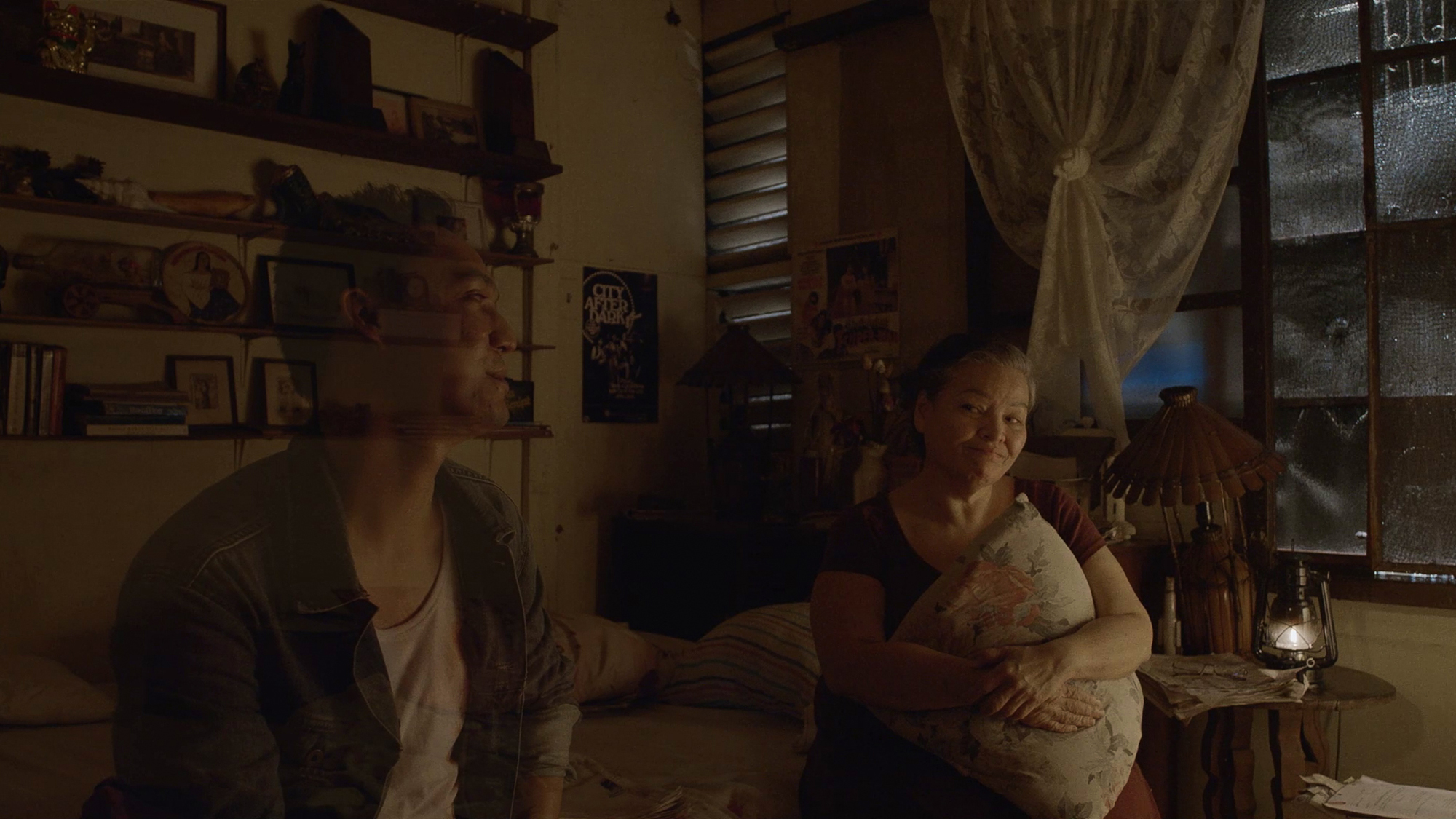Leonor Reyes doesn’t like living in reality. A famous action filmmaker in the 1980s, Leonor (played by Sheila Francisco) spends her days living vicariously through the films she watches on TV. Her son Rudie (Bong Cabrera), the last family member willing to live with her, has to remind her to behave like an adult—especially because their light bill is three months overdue. Instead of going to the payment center to resolve this issue, Leonor becomes distracted and purchases a new set of pirated DVDs from the corner store. When she returns to a home submerged in darkness and to an angry Rudie, Leonor does what she does best: she escapes.
The first few minutes of Leonor Will Never Die are hardly joyful, especially after Rudie takes a page from his mother and makes plans to migrate to another country. With no one else around her and nothing to distract her, she unearths one of her unfinished screenplays and begins immersing herself in it—crafting dialogue on her typewriter while animatedly narrating fight scenes and gunfire to an imaginary audience. All is well until a television falls out of a window and onto her head, thrusting her into the world of her own creation and inadvertently making her the star of her own 1980s Filipino action film.

Beneath the layers of meta-narrative, Martika Ramirez Escobar’s debut feature Leonor Will Never Die is a film centered on Leonor wrestling with loss—specifically surrounding the death of her favorite son Ronwaldo (Anthony Falcon). This entry into her own creative output is in line with philosopher and art critic Kathleen Marie Higgins’s piece “Aesthetics and the Containment of Grief,” which describes that “profound loss catapults the bereaved person into an alternate ‘world’ that differs in marked ways from the world we usually occupy.” Escobar physicalizes the emotional distance between Rudie and Leonor by first separating them into the planes of reality and fiction, respectively, freeing them from each other’s presence and allowing them to discover what they need.
Leonor Will Never Die falls into the definitions of what film critic Richard Armstrong describes as a ‘mourning film’—a motion picture wherein a female protagonist, muted by an unresolvable incident of trauma and disenfranchised grief, reckons with her increasing self-delusion and loss of self-agency. Many of Escobar’s earlier works revolve around similar themes, consistently using magic realism as a means to explore spectatorship, grief, and the ways film serves as a space to evade, articulate, and confront loss. In the world of her screenplay, Leonor is no longer the mere spectator but rather the center of the action.
Here, her deceased son is resurrected as the Filipino action film star who shares his name (hereafter referred to as Fictional Ronwaldo, played by Rocky Salumbides) and unlike in reality where she barely has a voice, Leonor has control of everything in her fictional albeit predictable world. She recites lines of dialogue as they come out of her characters’ mouths, alters the course of the story through her imagination, and even types her own salvation when needed.
The safety that fiction provides gives Leonor a space to articulate her grief clearly—narrating in detail, for the first time, at least for audience members, how Ronwaldo died after playing with a loaded prop gun on one of her sets; a loss that becomes more devastating when one realizes that she loses not only her son but her tether to the life-giving force of creation, too. By helping out Fictional Ronwaldo, Leonor taps into the force of creation as a way to regain some form of agency that was stripped away in the aftermath of Ronwaldo’s death. In ensuring that he saves the burlesque dancer Majestika (Rea Molina) from her jealous ex-boyfriend Junior (Ryan Eigenmann) and the Mayor’s (Dido dela Paz) corrupt henchmen, Leonor atones for her lapses as a mother, keeping him alive, at least in cinema.
In this plane where fiction and reality meet, where the dead are alive and dancing with the living, grief is dwarfed by the act of commemoration, of celebrating life, of gratitude.
Parallels can be drawn between Leonor Reyes and Cinta dela Cruz, the protagonist of Escobar’s debut short Pusong Bato (2014). A middle-aged actress who rewatches reels of her days as a lead in 1970s romcoms, Cinta only stops pining for the past once she abandons her present life and transforms into a rock to be with her partner who is also a rock, the transmutation a proof of her love. Similarly, Leonor’s desire to be with her Ronwaldo transforms her into a character within her screenplay, with her body later disappearing completely from the hospital once she commits to being in this fiction.
As the film progresses, another film emerges within Leonor Will Never Die—the film about Rudie losing Leonor.
Parallels can be drawn between Rudie and the titular character of Escobar’s short film Dindo (2014), the son of a film editor who takes up the practice in the hopes of understanding the fixations that preoccupied his deceased father. When Dindo begins talking to the characters of his late father’s film onscreen, they assist him in finding fragments of his past he thought were unrecoverable. Later, Escobar extends the conversation by having him break the fourth wall, asking its audience to communicate with Dindo directly.
Like Dindo, Rudie begins to immerse himself in the filmmaking process to bring himself closer to his mother. After Leonor is hospitalized, Rudie first acts out several lines from his mother’s script from the privacy of her bedroom then later speaks to his estranged father Valentin (Alan Bautista) about having her screenplay produced. The physical separation between Leonor and Rudie emerged from their emotional distance, and only by engaging with the act of creation that Leonor used to process her experiences does Rudie empathize with the depth and demand of his mother’s grief. With filmmaking becoming the shared language between the two, the lines between fiction and reality are blurred and Rudie is able to enter her world by bashing his head against a TV at the hospital.
Escobar loads Leonor Will Never Die with physicalizations of Leonor’s life, capturing the intangible specters that haunt her past and present. Grief is rarely fully articulated in the film and our protagonists are only able to manageably confront the enormity of their loss once it is turned into an object—from photocopies of Ronwaldo’s face to shapeshifting clips of Leonor’s brain generated by feeding brain scans to a StyleGAN-like software to a final film.

Throughout the film, Leonor and Rudie struggle to arrive at a satisfying ending to their stories, rewriting and re-editing the film and growing closer with each iteration but only asymptotically. How can one approximate the value of life and condense it into a few hours of spectacle? What conclusion would even do justice to the kind of life that a loved one lives and all the ones they failed to live out? The multiple endings of Leonor Will Never Die, including one that shows a third reality intervening with how the film is edited, forwards the most important aspect of creating a language of loss in cinema—the negotiation of death.
In Armstrong’s 2012 book Mourning Films: A Critical Study of Loss and Grieving in Cinema, he writes about how “cinema is a space in which we see someone who is no longer there,” emphasizing the duality of cinema as the “play of presence and absence.” The production process and the meta-narrative itself function as a scaffold that substitutes for structured mourning, which has grown increasingly rare due to the social distancing caused by the pandemic. Through the act of filmmaking, Rudie negotiates Leonor’s death with Escobar and editor Lawrence S. Ang, allowing her to live even just a little bit longer through suspension of disbelief.
Mourning is an act that seems to have no end. But Leonor Will Never Die refuses to wallow in this seemingly Sisyphean task and breaks away from the traditions of films such as Alain Resnais’ Hiroshima mon amour or Krzysztof Kieślowski’s Three Colors trilogy. Unlike Armstrong’s descriptions, Leonor Will Never Die does not linger in the “void between words” nor does it find “comforts and platitudes [in] the past.” Nor does it take after the tradition of Joe Wright’s Atonement by completely succumbing to the fiction of the film, guilt overflowing from the narrative once its layers are cracked open. Instead, Escobar crafts characters that are constantly attempting to articulate the crater that death leaves them, even if they fail.
The decision to end the film with a musical number may seem incongruous or out of place. But it is a decision that continues this negotiation of death, resists the silence that is often associated with mourning, and imbues the film with unparalleled generosity. In this plane where fiction and reality meet, where the dead are alive and dancing with the living, where the present is no longer mired in the past, where film workers and fictional characters are celebrated equally, grief is dwarfed by the act of commemoration, of celebrating life, of gratitude.
In many places around the world, entertainment is dismissed only as a form of escapism. But Leonor Will Never Die shows that in the Philippines, cinema is a source of community, joy, and closure.
Leonor Will Never Die premiered at the 2022 Sundance Film Festival and will be having its US theatrical release at the Metrograph beginning November 25.

